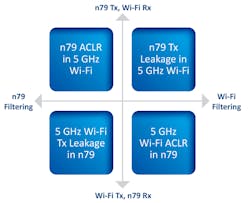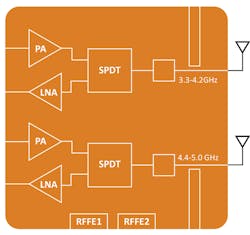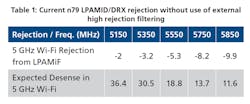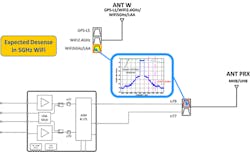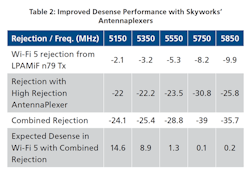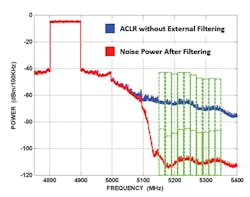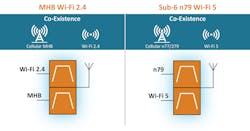5-GHz Wi-Fi Coexistence with 5G Cellular Improves the User Experience
The ever-increasing demand for higher data rates and reduced buffering times continues to drive the evolution of cellular communication and transmission. 5G promises to take performance to levels never seen before, with mounting pressure to deploy 5G handsets faster than any previous cellular standard.
With this urgency to release 5G smartphones, potential Wi-Fi coexistence issues have largely been ignored, even though Wi-Fi and 5G cellular are complementary technologies. Effective coexistence of the two technologies would greatly enhance the end-user experience. In fact, Wi-Fi data usage can reach as high as 92% of total smartphone data usage according to various analytics reports.
Furthermore, the 5-GHz Wi-Fi channel (802.11a/n/ac/ax) is being widely implemented in user equipment (UE) across the world, offering additional range beyond the traditional 2.4-GHz spectrum. Combined with the high speeds available in 5G, the efficient utilization of both Wi-Fi and 5G spectrums has the potential to offer substantially increased data rates with negligible latency. Therefore, it’s important that Wi-Fi remain an integral part of smartphones and complement 5G to provide the optimal user experience.
Interference Issues
Due to the proximity of cellular and Wi-Fi channels in 2.4- and 5-GHz spectrums, utilizing both Wi-Fi and New Radio (NR) spectrums can cause interference during operation. The 2.4-GHz Wi-Fi channel is adjacent to the n41, n40, and n7 spectrum, while the n79 band is adjacent to the 5-GHz Wi-Fi channel (Fig. 1).
This poses serious interference threats due to transmit (Tx) leakage and adjacent channel leakage ratio (ACLR) in respective bands, which can greatly impact data rates if appropriate filtering isn’t used. In addition, there is the potential risk of hardware damage due to high power signals reaching receive (Rx) paths. Figure 2 shows a simple illustration of interferences in the n79 and Wi-Fi coexistence cases.
To date, neither carriers nor OEMs have required n79 coexistence with 5-GHz Wi-Fi channels. Therefore, current RF front-end (RFFE) implementations don’t take this into account. A significant desensitization (desense) in 5-GHz Wi-Fi channels may result if no additional measures are taken.
The use of external high-rejection filters and antennaplexers (Fig. 4) can help remedy this issue. With rejection up to 25 to 35 dB, utilizing one of Skyworks’ antennaplexers can greatly improve the desense and enable the end-user device to achieve the coexistence needed for proper utilization of both spectrums. Table 2 demonstrates the enhancement.
Hardware Filtering
While some techniques are available to help improve coexistence performance, the use of hardware filtering for coexistence can offer multiple advantages, including higher throughput, which translates directly into faster data rates. Hardware filtering is also platform-agnostic, offering OEMs the flexibility to use the transceiver platform of their choice. In addition, it removes any restriction on Wi-Fi and the end-user benefits from hotspot or external-AP modes. Most importantly, hardware filtering is future-proof, so any additional band combinations would not affect the filtering, particularly as 5G continues to evolve and new bands are allocated.
An example of hardware filtering can be found in Skyworks’ n77 to n79 antennaplexer, which offers rejection of greater than 25 dB with low insertion loss and enables coexistence between Wi-Fi and n79 frequencies (Fig. 5).
A similar concept can be extended to the mid-high band 2.4-GHz Wi-Fi filtering to enable n7 and n41 to 2.4-GHz Wi-Fi and n40 to 2.4-GHz Wi-Fi n79 coexistence (Fig. 6). External implementation of the filter also allows flexibility in some SKUs where certain bands may not be required.
In addition, potential application scenarios exist in NR/LAN interworking and NR/WLAN dual connectivity, which have been discussed in 3GPP as a working item. Having a hardware-based solution will enable UE to take advantage of this advanced capability.
Jin Cho is in Product Marketing Management, Tanuj Khurana is Product Marketing Manager, Justin Lee is Product Marketing Manager, and Anand Raghavan is Principal Systems Engineer at Skyworks Solutions.


